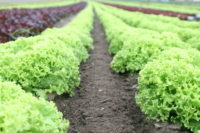FDA Announces Findings From Sampling of Romaine Lettuce in Yuma, AZ

The U.S. Food and Drug Administration (FDA) has released its findings from a sampling assignment for which it collected and tested romaine lettuce from commercial coolers in Yuma County, Arizona during February and March 2021. The lettuce was tested for Shiga toxin-producing Escherichia coli (STEC), specifically enterohermorrhagic E. coli (EHEC), and Salmonella spp. The findings were part of FDA's ongoing surveillance following recent multistate E. coli O157:H7 outbreaks of foodborne illness which were linked or possibly linked to romaine lettuce.
FDA's purpose in conducting this assignment was to determine whether the target pathogens and specific strains were present in romaine lettuce from the Yuma region to help prevent foodborne illness when possible. If FDA found product that tested positive for EHEC or Salmonella, it planned to work with industry and state regulatory partners to identify the cause to inform future regulatory and/or research effects. It will also develop strategies that could help prevent additional outbreaks.
FDA collected 504 romaine samples for EHECs and Salmonella spp., with testing performed by an independent laboratory on contract, as part of a pilot project. Each sample included 10 subsamples, and each subsample consisted of at least 300 grams of romaine lettuce, including whole heads, hearts, or individual leaves. The purpose of collecting and testing samples composed of multiple subsamples is to increase the probability of detecting pathogens if present, since microbial hazards may not be uniformly present.
E. coli O130:H11 was only detected in one sample. It was found to be moderate to high risk and could be capable of causing severe illness in humans, although it was not linked to any known human illnesses; in addition, no product ever reached consumers. As a precaution, the owner of the product did not harvest the remaining crop from the field where it was grown.
In response to this, FDA held an investigation at the farm to identify probably sources and routes of contamination. FDA was able to collect romaine lettuce from the field, as well as multiple samples of soil, water, sediment, and animal fecal material. FDA also assessed farm equipment and other surfaces. The one sample (out of 24 samples) that yielded STEC came from the outer leaves of romaine lettuce, and was further characterized as low risk to human health. FDA analysis indicated the strain was not linked with any past known foodborne illness outbreaks, as well.
Romaine lettuce and leafy greens are among the most widely consumed vegetables in the U.S., and helping to ensure the microbiological safety of leafy greens continues to be a priority of FDA. Recently, FDA released its Leafy Greens STEC Action Plan (LGAP), which features public health approaches to response, prevention, and addressing knowledge gaps. FDA continues to collaborate with industry, states, academic, and other stakeholders through activities outlined in the LGAP to address issues with leafy greens.
Related: FDA Announces Results of Romaine Lettuce Sampling Assignment
Looking for a reprint of this article?
From high-res PDFs to custom plaques, order your copy today!








